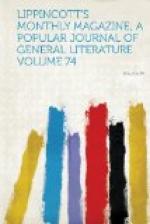Slains Castle had many gentle and pleasant memories about it, as well as its traditional horrors, and among these were many connected with the history of the old family that owned it. In one of the corridors hangs the picture of James, Lord Hay, a fair-haired, sunny-faced boy, tall and athletic, standing with a cricket-bat in his hand. He would have been earl of Erroll had he lived, but if we follow him in his short life from classic Eton to the field of Quatre-Bras, we shall find him again, on a bright June day in 1815, lying as if asleep, as fair and noble-looking as before, but silent in death. Simple Flemish peasants stand in a group around him, awed and admiring, asking each other if this beautiful youth is an angel fallen from heaven, or only a mortal man slain for the Honor of his country. His was a noble death, and worthy of the suggestive memento of his early boyhood before which we stood just now in the corridor of Slains Castle.
A little farther down this corridor, which to all intents and purposes is a family picture-gallery, we shall be forced to stop before the portrait of a dark woman, masculine and resolute, not beautiful nor like the handsome race of the Hays, of which she was yet the last direct representative. This is the famous Countess Mary, one of the central figures of the family traditions. The Hays were hereditary lords high constable of Scotland, and also one of the few Scottish families in which titles and offices, as well as lands, are transmitted through the female line. So this Countess Mary found herself, at the death of her brother, countess of Erroll in her own right and lord high constable of Scotland.




